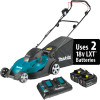Makita XML02PT XML02 Instruction Manual - Page 3
Save These Instructions.
 |
View all Makita XML02PT manuals
Add to My Manuals
Save this manual to your list of manuals |
Page 3 highlights
18. Use identical replacement blades only. 19. This cutting machine is capable of amputating hands and feet and throwing objects. Failure to observe the following safety instructions could result in serious injury or death. 20. Only allow responsible adults, who are familiar with the instruction, to operate the mower. 21. Be sure the area is clear of other people before mowing. Stop mower if anyone enters the area. 22. Never direct discharged material toward anyone. Avoid discharging material against a wall or obstruction. Material may ricochet back toward the operator. Stop the blade when crossing gravel surfaces. 23. Do not pull the mower backwards unless absolutely necessary. When you are compelled to back the mower from a fence or other similar obstruction, look down and behind before and while moving backwards. 24. Release switch lever and wait for blade rotation to stop before crossing driveways, walks, roads and any gravel-covered areas. Also remove key if you leave it, reach to pick up or remove something out of your way, or for any other reason that may distract you from what you are doing. 25. Do not operate machine without the entire grass catcher, discharge guard, rear guard, or other safety protective devices in place and working. 26. Stop the motor and remove the key whenever you leave the equipment, before cleaning the mower or unclogging the chute and making any repairs or inspections. 27. Shut the motor off and wait until the blade comes to a complete stop before removing the grass catcher. Beware that the blades coast after turn off. 28. Mow only in daylight or good artificial light. 29. Disengage the self-propelled mechanism or drive clutch on the mower so equipped before starting the motor. 30. If the equipment should start to vibrate unusually, stop the motor and check immediately for the cause. Vibration is generally a warning of trouble. 31. Do not insert key into mower until it is ready to be used. 32. Don't grasp the exposed cutting blades or cutting edges when picking up or holding the appliance. 33. Check the blades carefully for cracks or damage before operation. Replace cracked or damaged blades immediately. 34. Never attempt to make wheel height adjustments while mower is running. 35. Check the grass basket frequently for wear or deterioration. For storage, always make sure the grass basket is empty. Replace a worn grass basket with a new factory replacement one for safety. 36. Check grass basket components and the discharge guard frequently and replace with manufacturer's recommended parts, when necessary. 37. Mow across the face of slopes, never up and down. Exercise extreme caution when changing direction on slopes. Do not mow excessively steep slopes. 38. Watch for holes, ruts, bumps, rocks, or other hidden objects. Uneven terrain could cause a slip and fall accident. Tall grass can hide obstacles. 39. Do not mow on wet grass or excessively steep slopes. Poor footing could cause a slip and fall accident. 40. Do not wash with a hose; avoid getting water in motor and electrical connections. 41. Check the blade mounting bolt at frequent intervals for proper tightness. 42. Keep all nuts, bolts, and screws tight to be sure the equipment is in safe working condition. 43. Never remove or tamper with safety devices. Check their proper operation regularly. Never do anything to interfere with the intended function of a safety device or to reduce the protection provided by a safety device. 44. Maintain or replace safety and instruction labels, as necessary. 45. Battery tool use and care • Recharge only with the charger specified by the manufacturer. A charger that is suitable for one type of battery cartridge may create a risk of fire when used with another battery cartridge. • Do not charge lawn mower in rain, or in wet locations. • When replacing batteries, all batteries should be replaced at the same time. Mixing fresh and discharged batteries could increase internal cell pressure and rupture the discharged battery. • Use power tools only with specifically designated battery cartridges. Use of any other battery cartridges may create a risk of injury and fire. • When battery cartridge is not in use, keep it away from other metal objects, like paper clips, coins, keys, nails, screws or other small metal objects, that can make a connection from one terminal to another. Shorting the battery terminals together may cause burns or a fire. • Under abusive conditions, liquid may be ejected from the battery; avoid contact. If contact accidentally occurs, flush with water. If liquid contacts eyes, additionally seek medical help. Liquid ejected from the battery may cause irritation or burns. SAVE THESE INSTRUCTIONS. WARNING: Use of this product can create dust containing chemicals which may cause respiratory or other illnesses. Some examples of these chemicals are compounds found in pesticides, insecticides, fertilizers and herbicides. Your risk from these exposures varies, depending on how often you do this type of work. To reduce your exposure to these chemicals: work in a well ventilated area, and work with approved safety equipment, such as those dust masks that are specially designed to filter out microscopic particles. 3 ENGLISH












